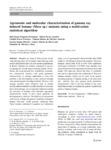Please use this identifier to cite or link to this item:
http://www.alice.cnptia.embrapa.br/alice/handle/doc/879403Full metadata record
| DC Field | Value | Language |
|---|---|---|
| dc.contributor.author | PESTANANA, R. K. N. | pt_BR |
| dc.contributor.author | AMORIM, E. P. | pt_BR |
| dc.contributor.author | FERREIRA, C. F. | pt_BR |
| dc.contributor.author | AMORIM, V. B. de O. | pt_BR |
| dc.contributor.author | OLIVEIRA, L. S. | pt_BR |
| dc.contributor.author | LEDO, C. A. da S. | pt_BR |
| dc.contributor.author | SILVA, S. de O. e. | pt_BR |
| dc.date.accessioned | 2011-07-20T01:10:23Z | - |
| dc.date.available | 2011-07-20T01:10:23Z | - |
| dc.date.created | 2011-02-28 | pt_BR |
| dc.date.issued | 2011 | pt_BR |
| dc.identifier.citation | Euphytica, Wageningen, v. 178, n. 2, p. 151-158, mar. 2011. | pt_BR |
| dc.identifier.uri | http://www.alice.cnptia.embrapa.br/alice/handle/doc/879403 | pt_BR |
| dc.description | Bananas are tropical fruits grown world-wide playing a key role in market trade and especially used as main food source for low income populations. In Brazil, bananas are mainly consumed in natura, occupying the second largest internal market. Nevertheless, this crop presents low availability of productive commercial varieties with good agronomic characteristics. A strategy undertaken to solve this problem is the development of new cultivars through conventional genetic breeding methods. However, this strategy presents some obstacles such as female sterility and low number of seeds. In order to overcome these shortcomings, use of mutation induction aiming the selection of mutants with desirable agronomic characteristics seems to have great potential for developing new cultivars. The objective of the present work was to evaluate the genetic variability in putative banana Pacovan (AAB genome, subgroup Prata Type) mutants submitted to gamma ray irradiation, using a set of agronomical and molecular data (ISSR markers). The distance between the putative Pacovan mutants varied from 0.26 to 0.64 with cophenetic correlation coef?cient of 0.7669. Four mutants were selected based on best agronomical characteristics and height. This data also shows that there is variability that can be explored after the irradiation of Pacovan banana mutants, which can be used in the genetic breeding program of banana aiming to develop short new varieties that also present good agronomic characteristics. This is the first attempt to use combined data in order to evaluate the genetic variability in putative banana mutants. | pt_BR |
| dc.language.iso | eng | eng |
| dc.rights | openAccess | eng |
| dc.subject | ISSR markers | pt_BR |
| dc.subject | Multivariante analysis | pt_BR |
| dc.title | Agronomic and molecular characterization of gamma ray induced banana (Musa sp.) mutants using a multivariate statistical algorithm. | pt_BR |
| dc.type | Artigo de periódico | pt_BR |
| dc.date.updated | 2011-07-20T01:10:23Z | pt_BR |
| dc.subject.thesagro | Banana | pt_BR |
| dc.subject.thesagro | Musa sp | eng |
| dc.description.notes | Também disponível em: <http://www.springerlink.com/content/0014-2336/178/2/>. PESTANANA, R. K. N. i.e., PESTANA, R. K. N. | pt_BR |
| riaa.ainfo.id | 879403 | pt_BR |
| riaa.ainfo.lastupdate | 2011-07-19 | pt_BR |
| dc.contributor.institution | Rosa Karla Nogueira Pestana, UFRB; EDSON PERITO AMORIM, CNPMF; CLAUDIA FORTES FERREIRA, CNPMF; Vanusia Batista de Oliveira Amorim, FAPESB/CNPq; Larissa Santos Oliveira, UFRB; CARLOS ALBERTO DA SILVA LEDO, CNPMF; Sebastiao de Oliveira e Silva, CNPMF. | pt_BR |
| Appears in Collections: | Artigo em periódico indexado (CNPMF)  | |
Files in This Item:
| File | Description | Size | Format | |
|---|---|---|---|---|
| PESTANAID27500.pdf | 350,9 kB | Adobe PDF |  View/Open |









